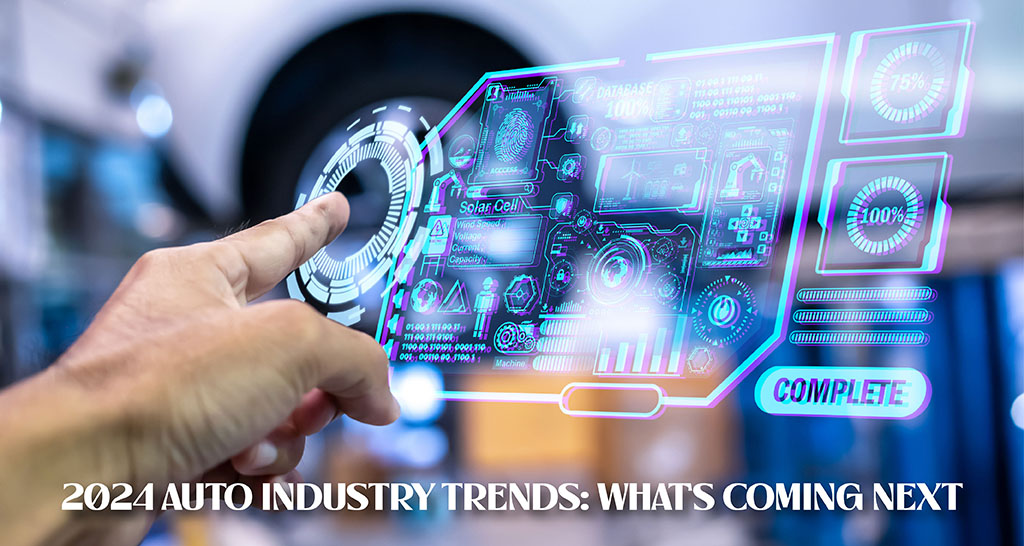“Cars are the greatest invention for humans to travel while making it look cool.” – Anonymous.
In the past three years, the automotive industry has seen significant changes. This period, marked by the challenges of a global pandemic, has seen vehicle supply chains thrown into chaos, sparking a need for rapid adaptation. Manufacturers and dealerships had to adjust to these unmatched changes and evolving global demands quickly.
As 2023 draws to a close, it’s essential to cast our eyes forward to 2024. The industry faces a complex landscape: the meteoric rise in electric vehicle sales, the impact of inflation, and challenges like labor strikes and parts shortages.
It’s a critical time for the industry to remain alert and adaptable, ready to respond to the market dynamics and consumer needs. So, without further ado, let’s dig into a few of the latest auto industry trends.
The Electrifying Journey of EVs and Hybrids into 2024
As we approach 2024, the auto industry’s move toward electric vehicles is picking up speed but encountering challenges. In 2023, EVs saw a 55% sales boost in the first half compared to the previous year. It’s an exciting time, with almost 40% of Americans thinking about getting an EV as their next car.
Yet, this electric wave is not without its challenges. The higher upfront costs of EVs are a significant consideration for many. Additionally, the logistics of home charging and the current state of charging stations, while getting better, still make some drivers uneasy. Such factors are crucial detours on the road to widespread EV adoption.
With that, hybrids are quietly making a significant impact. They are becoming a preferred choice for both automakers and consumers, offering a bridge between traditional fuel engines and full electrification.
Contrary to some predictions, they’re still around for a while. In essence, the automotive scene of 2024 shows a diverse lineup: the persistence of IC vehicles, the rise of hybrids, and the growing allure of EVs.
Protecting Your Car with Ceramic Coatings
Each day, your car faces environmental challenges like salt, dirt, bird droppings, and acid rain that can harm its paint and appearance. Traditional car wax and polish provide some protection, but they don’t offer a strong defense.
Whether it is a family sedan or a luxury sports car, ceramic Paint Protection is tailored to every model. These coatings are a game-changer in automotive care. But why stop there? The ultimate shield for your vehicle comes from combining the resilience of ceramic car coatings with the traditional practice of waxing and polishing.
This combination not only makes your car look great but also protects it from rust and other harm.
By embracing this comprehensive approach, automobile owners gain enhanced protection, superior resistance, and longevity. It ensures their car retains its perfect condition and beauty for years to come.
The Digital Transformation of Vehicles
Vehicles are no longer just modes of transportation; they are evolving into fully connected devices. This paradigm shift is revolutionizing the entire vehicle experience. Manufacturers are now integrating comprehensive software suites that seamlessly connect with other smart devices.
It helps create personalized user experiences, enables convenient over-the-air updates, and drives the development of advanced infotainment systems. However, with this increased connectivity comes a risk of data breaches and cyberattacks. Vehicle cyber threats are a growing concern for consumer cybersecurity.
This necessitates dealers to provide robust training and comprehensive protection solutions to ensure the safety and privacy of their customers.
The desire for personalized experiences extends to the car-buying process as well. There has been a profound shift towards the use of digital tools in automotive retail. Surprisingly, 59% of vehicle buyers now prefer using digital tools provided by dealerships. These tools make buying a car easier by helping you with financing, vehicle selection, and access to educational resources for informed decisions.
Supply Chain Challenges
The auto industry has been grappling with supply chain challenges, including issues like the United Auto Workers (UAW) strike and a shortage of semiconductor chips. These disruptions have created an unpredictable market.
These challenges have far-reaching effects, impacting both dealerships and consumers. They result in limited vehicle availability and higher prices. Between 2020 and 2021, new car prices increased by 17.2%. While prices are starting to stabilize as inventory levels recover, dealerships need to remain flexible and prepared for potential operational changes.
Wrapping Up
Predicting 2024 in the automotive industry is like reading tea leaves; uncertainty is the only constant. Rapid tech advancements, regulations, market shifts, interest rates, and global events keep us on our toes. History does show that change can happen overnight. Stay informed, be flexible, and embrace resilience as we navigate the ever-changing road ahead.

